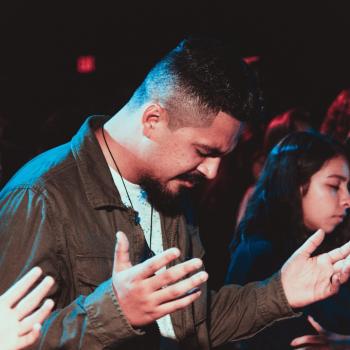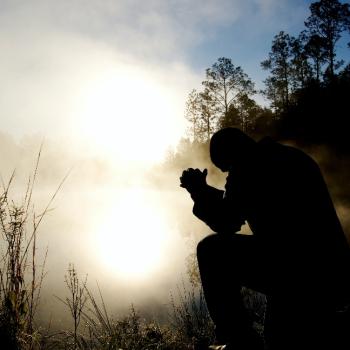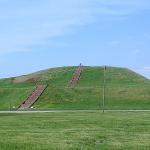Revelation 5:1-14 Seven Characteristics of Jesus Christ on the Throne
In Revelation 1, we saw a picture of Jesus Christ as He appeared to John. This picture of Jesus was to show Him as someone who would encourage the church during the difficult times they would soon encounter. In Revelation 5, we see Jesus Christ as Someone Who would have power over the events that would “soon take place.” Revelation 5 provides us a powerful picture of Jesus on the throne. Here we see seven characteristics of Jesus Christ on the Throne.
Chapter 5 is a continuation of the throne-room vision begun in chapter 4 so that the chapter division added here is essentially disruptive. The focus moves from the central figure on the throne and the worshippers to an inscribed book in the hand of God. The pageantry of the vision becomes so intense that John finds himself weeping over the search to find one worthy to open the book. The introduction of the Lamb is both startling and comforting and provides the solution for the heavenly search.1
The Seven Characteristics of Jesus Christ on the Throne (5:1-14)
1. The Scroll (Revelation 5:1-4)
The scroll which the One on the throne (God) gives to Jesus is a special scroll.
Most interpreters have rightly identified the phrase of 5:1b, “a scroll/book written on the front and back,” as evoking the image of Ezekiel 2:9b–10. John’s scroll, like Ezekiel’s, will contain “lamentations, mourning, and woe” (Ezekiel 2:10). The biblion (“book”) is further described by the phrase “having been sealed with seven seals,” which appears to be a merging of Daniel 12:1, 4, 9 with Isaiah 29:11.2
Revelation 5 states that the figure represented upon the throne is none other than the Father because the Son will take a scroll from him. This is reminiscent of the picture of the Son receiving rule from the Ancient of Days in Daniel 7. The Lamb’s acceptance of the scroll begins the passages concerning God’s judgment.
This passage parallels Exodus as well. The burning bush is the first revelation in the symbol of fire. This encounter with God is where God gives Moses his plan for Israel’s redemption from slavery. He shares with Moses his directives on how to be prepared to face Pharaoh and how to prepare God’s People for what is to come. He assures Moses of victory and his awesome identity.34
The scroll represents Christ’s “title deed” to all that the Father promised Him because of His sacrifice on the cross. 5 The title deed is rulership of the Earth.
Initially, a title deed would be written only on the smooth side and sealed with a single seal (Jeremiah 32:6–29). But if the owner became unable to meet his financial obligations, he would have to relinquish his title deed—upon the backside of which would be written his debts and upon which would be placed seven seals. If at any time during the ensuing seven years he could pay off his debts, the seals would be broken and the title deed returned.6
In Roman law, according to some evidence, a testament was sealed with seven seals by seven witnesses before its legality could be established. Clearly, the authority of heaven itself rests on this book thus written and sealed.7
It’s the title deed to planet earth. The title deed to this planet was originally given to Adam in the Garden of Eden when God told him to subdue the earth (Genesis 1:28). But Adam forfeited his right to ownership when he ate of the fruit of the tree of the knowledge of good and evil. You see, although Eve was tricked into eating the forbidden fruit, Adam’s was an overt, calculated act of rebellion, which is why the Bible speaks of Adam’s sin as that which transferred to Satan the title deed of our planet (Romans 5:14). This explains why Paul called Satan the god of this world (2 Corinthians 4:4) and why Jesus referred to him as the prince of this world (John 12:31).8
2. The Mighty Angel (Revelation 5:2)
The scroll is given to a mighty angel. Mighty angels are used to deliver powerful items. Here it is a scroll that contains the rights to the Earth that can only be handed to Jesus.
“Then I saw another mighty angel coming down from heaven, surrounded by a cloud, with a rainbow over his head. His face was like the sun, his legs were like fiery pillars,” (Revelation 10:1, HCSB)
He announced the thunder judgments. Judgments which were not recorded by John. Then this same mighty angel gave John a scroll of prophetic judgment which John was to proclaim.
“Then a mighty angel picked up a stone like a large millstone and threw it into the sea, saying: In this way, Babylon the great city will be thrown down violently and never be found again.” (Revelation 18:21, HCSB)
Another mighty angel used a stone to prophecy about the destruction of Babylon.
3. The Lion/Lamb (Revelation 5:5-6)
Leviticus 25:23-25 states that God owns the land. He states that if a person loses possession of the land, a nearest relative can redeem a land that has been sold.
““The land is not to be permanently sold because it is Mine, and you are only foreigners and temporary residents on My land. You are to allow the redemption of any land you occupy. If your brother becomes destitute and sells part of his property, his nearest relative may come and redeem what his brother has sold.” (Leviticus 25:23–25, HCSB)
The book of Ruth tells the story of a man who redeems the land for a Jewish family. Ruth clarifies that only a Goel, a kinsman redeemer, could redeem the land. Adam had forfeited his dominion of the Planet Earth, and John sobbed convulsively because no “man” (a kinsman) could be found qualified to redeem the deed. But, fortunately, Someone was found who was qualified, able, and willing.9
In the story of Ruth a kinsman redeemer is asked by Boaz to take back her inheritance. This kinsman redeemer, who is unnamed (and is a pre-incarnate form of Jesus Christ) states that He will ruin His own inheritance if He takes Ruth as His wife and Naomi’s inheritance.
“The redeemer replied, “I can’t redeem it myself, or I will ruin my own inheritance. Take my right of redemption, because I can’t redeem it.”” (Ruth 4:6, HCSB)
What inheritance is it that the Kinsman Redeemer will forfeit? The inheritance of ruling the Earth. He declined it in Ruth so that He could take it in Revelation.
But with both God the Father and the Holy Spirit present in Heaven, how is it that only Messiah was worthy to open the scroll? In this context, to become worthy to open the Seven-Sealed Scroll required one to die for sins and then be resurrected. Only the Son was worthy in this respect.10
But here the central paradox of Revelation and of Christian faith in general comes to the fore: Jesus conquered not by force but by death, not by violence but by martyrdom. The Lion is a Lamb! Regularly in ancient literature, lions functioned as images of great strength—the courageous, powerful rulers of the animal kingdom (Revelation 9:8, 17; 10:3).11 Even Jewish texts use the image of a lion for courage and power in general more often than specifically for the Messiah. John turns, expecting to witness a powerful hero. Yet the Lamb, by contrast, provides an image of helplessness.
4. The Seven-fold Spirit of God (Revelation 5:6)
In Revelation, the “seven spirits of God” refer to the Holy Spirit. The Spirit’s being “sent out into all the earth” echoes Jesus’s words about the sending of the Holy Spirit to empower the church to participate in God’s mission in this world (John 14:26; 15:26; 16:7). Jesus is both one with God on his throne and one with the Holy Spirit in the executing of God’s will.12
Horns in prophetic literature sometimes represent power (Daniel 7:7–24; 8:3–22), but here the power is not human power, but the seven spirits of God (Revelation 5:6); this alludes to the ancient prophecy that the Jewish king must prevail not by human strength but by the power of the Spirit (Zechariah 4:6).
John identifies the horns here with seven eyes (Revelation 5:6), which he probably understands as representing the Spirit in Zechariah’s vision (Zechariah 3:9; 4:6, 10) as well as the seven lamps (Zechariah 4:2; Revelation 4:5). But in Zechariah, the eyes that watch over God’s purposes and his people belong to God himself; their application to Jesus the Lamb provides a clue to Jesus’ true, exalted identity.
The number seven represents completeness. Horns represent authority. Eyes represent perception. And all that is enabled by the Seven Spirits of God, the Old Testament idiom for the Holy Spirit (Isaiah 11:2).13
In Zechariah 4 the symbols of the “seven lamps” (4:2) and the “seven eyes” (4:10) are associated with Yahweh’s omnipotent Spirit.14
5. Prayers of the Saints (Revelation 5:8)
The heavenly chorus offers not to God the Father but to Jesus the prayers of the saints (5:8), prayers that directly invite the plagues he will soon release for their vindication (6:10; 8:4–6).1516
6. The New Song of Worship (Revelation 5:9-10)
The song is new because Jesus is going to do a new thing. He will judge the world. He will set Himself up as ruler of Heaven and Earth.
SEVEN TIMES EVERYONE IS ACKNOWLEDGED IN REVELATION17
1. Purchased for God by Christ (Revelation 5:9)
2. Great Multitude in Heaven (Revelation 7:9)
3. John is called to prophesy against this group (Revelation 10:11)
4. Unbelievers who refuse to bury the two witnesses (Revelation 11:9)
5. The Beast is given authority over unbelievers (Revelation 13:7)
6. The Gospel is proclaimed to everyone (Revelation 14:6)
7. The Prostitute sits over this group (Revelation 17:15)
7. The Worshipers (Revelation 5:10-14)
Everyone will worship God. Everyone will worship Jesus. This list in Revelation 5 shows the diversity of worshipers.
Angels, Four Living Creatures, 24 Elders
It is clear that these twenty-four Elders represent the redeemed. Only three personages in the Bible are kings and priests: Melchizedek (Genesis 14:18, Psalm 110:4, Hebrews 5:6, 10; 6:20-7:21), the Messiah, and His redeemed (Revelation 1:6, Revelation 20:6). The Elders represent the church in heaven.
Notice the sequence: the tribulation doesn’t start until the Seven-sealed Scroll is opened. The Lamb doesn’t receive the Seven-sealed Scroll until the Elders place their crowns on the glassy sea. And the Elders are obviously in heaven when that happens. Therefore, the church is in heaven before the wrath of God is poured out.18
Every Creature
If the seals attest the veracity of believers’ future inheritance in the kingdom (as we have suggested, albeit tentatively), then God’s judgments on the world around us should invite us not to fear but to hope. Judgments testify that God, not our oppressors, remains sovereign.19
1 Paige Patterson, Revelation, ed. E. Ray Clendenen, vol. 39, The New American Commentary (Nashville, TN: B&H, 2012), 162.
2 G. K. Beale and D. A. Carson, Commentary on the New Testament Use of the Old Testament (Grand Rapids, MI; Nottingham, UK: Baker Academic; Apollos, 2007), 1101.
3 The quality of supernatural vision also intensifies later when Moses climbs the mountain with the elders of Israel. The pavement of sapphire stone is described as having the clarity of the heavens. The amazing account describes eating and drinking in the presence of God. This also parallels John’s vision of the heavenly realm.
4 Daniel C. Juster, Passover: The Key That Unlocks the Book of Revelation (Clarksville, MD: Messianic Jewish Publishers, 2011), 22–23.
5 Warren W. Wiersbe, The Bible Exposition Commentary, vol. 2 (Wheaton, IL: Victor Books, 1996), 584.
6 Jon Courson, Jon Courson’s Application Commentary (Nashville, TN: Thomas Nelson, 2003), 1700.
7 Paige Patterson, Revelation, ed. E. Ray Clendenen, vol. 39, The New American Commentary (Nashville, TN: B&H, 2012), 162.
8 Jon Courson, Jon Courson’s Application Commentary (Nashville, TN: Thomas Nelson, 2003), 1700.
9 Chuck Missler, Learn the Bible in 24 Hours® (Nashville: Thomas Nelson, 2002).
10 Arnold G. Fruchtenbaum, The Footsteps of the Messiah : A Study of the Sequence of Prophetic Events, Rev. ed. (Tustin, CA: Ariel Ministries, 2003), 168.
11 Pervasive throughout literary sources: e.g., Homer, Il. 10.297, 485; 11.239, 548; Od. 4.724; 6.130; Virgil, Aen. 12.6; Apollonius Rhodius, 2.26–29; Babrius. 1, 65, 90–92, 95, 97, 101, 103, 105–7, 139; Phaedrus, 1.5; 4.14.2; Seneca, Dial. 4.11.4; Martial, 1.60; Cornelius Nepos, 18.11.1.
12 J. Scott Duvall, Revelation, ed. Mark L. Strauss and John H. Walton, Teach the Text Commentary Series (Grand Rapids, MI: Baker Books, 2014), 90–91.
13 Chuck Missler, Learn the Bible in 24 Hours® (Nashville: Thomas Nelson, 2002).
14 G. K. Beale and D. A. Carson, Commentary on the New Testament Use of the Old Testament (Grand Rapids, MI; Nottingham, UK: Baker Academic; Apollos, 2007), 1101.
15 One might think of intercessions of departed saints for people on earth, as in 2 Macc. 15:12, 14; 1 En. 39:5 (though Ps-Philo 33:4–5 opposes this concept); but Revelation itself speaks of cries for vindication (Rev. 6:10; 8:4–6), which also brings judgment in 1 Enoch 97:3–5.
16 Craig S. Keener, Revelation, The NIV Application Commentary (Grand Rapids, MI: Zondervan Publishing House, 1999), 188.
17 J. Scott Duvall, Revelation, ed. Mark L. Strauss and John H. Walton, Teach the Text Commentary Series (Grand Rapids, MI: Baker Books, 2014), 96.
18 Chuck Missler, Learn the Bible in 24 Hours® (Nashville: Thomas Nelson, 2002).
19 Craig S. Keener, Revelation, The NIV Application Commentary (Grand Rapids, MI: Zondervan Publishing House, 1999), 193.
















